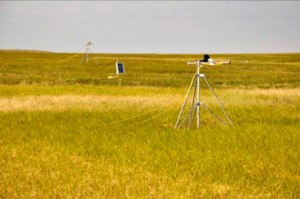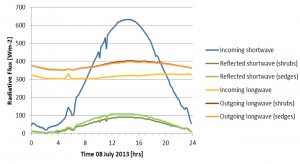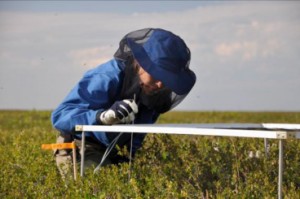by Gabriela Schaepman-Strub
Kytalyk, July 15, 2013
Yesterday we downloaded the first few days of data from the two energy flux towers on wet sedge and dry dwarf birch patches. The data looks reasonably good so far. We did catch a very sunny day resulting in a beautiful irradiance curve. The towers include an albedometer, net short- and longwave radiation sensors, air temperature thermistors, a nadir- and an oblique looking time-lapse camera used for assessing the phenology and snow melt patterns next year, as well as PAR sensors placed below the leaves to measure radiation transmitted through the canopy. Additionally we started with structural measurements – point quadrant measurements to estimate leaf area, active layer thickness (ALT) that is currently around 15cm for Betula nana patches, but already around 20cm for wet sedge areas. We are really looking forward to see how the fluxes of the two patches develop throughout the season and under varying atmospheric conditions.

The two energy flux towers, in the front the wet sedge patch with deep active layer, in the back the slightly elevated dwarf birch patch, both with the corresponding flux tower (Photo: G. Schaepman-Strub, 9 July 2013).

First energy flux measurements on an almost perfectly sunny day (08 July 2013). Plot includes incoming short- and longwave radiation, as well as reflected shortwave and outgoing longwave for shrub-dominated and sedge-dominated patches (Data: I. Juszak, G. Schaepman-Strub, UZH, 2013).

Inge Juszak busy with one of the 81 point quadrant measuring points. We note down every leaf and branch, as well as mosses or background type that the thin lowered needle is hitting at each point. Not an easy job to lean over the 1x1m grid and look through the canopy with a mosquito head-net on and hundreds of our dear friends flying around us (Photo: G. Schaepman-Strub, 9 July 2013).
PS: On the way to the plot I found a first edible mushroom of the season between dwarf birches – unfortunately will not provide a big meal ;-). It is quite tiny as compared to his relatives growing in Europe! More on collecting berries and mushrooms will probably follow when I am off already to Russkoye Ustye, a small village further up North. I remember that in 2010 walking through the tundra was very slow as we constantly stopped to pick some salmon-colored beautiful and tasty cloudberries to increase our vitamin C level …!

